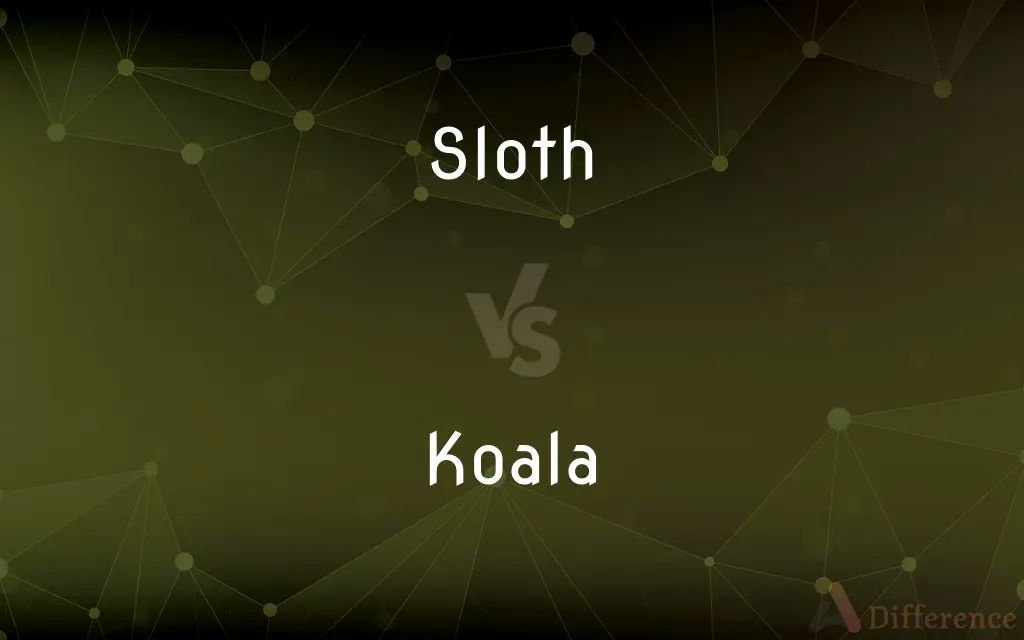Sloth vs. Koala — What's the Difference?
Edited by Tayyaba Rehman — By Fiza Rafique — Updated on November 6, 2023
Sloths are slow-moving arboreal mammals from South and Central America, while koalas are Australian marsupials that live in eucalyptus trees.

Difference Between Sloth and Koala
Table of Contents
ADVERTISEMENT
Key Differences
Sloths and koalas are both tree-dwelling animals, but they come from different parts of the world. Sloths are native to the rainforests of Central and South America, where they spend most of their time in the canopy. In contrast, koalas are found in the eucalyptus forests of Australia, clinging to trees and feeding almost exclusively on eucalyptus leaves.
Both sloths and koalas have adaptations for their arboreal lifestyles. Sloths possess long limbs and hooked claws to hang from branches, moving infamously slow to conserve energy. Koalas, on the other hand, have strong limbs and sharp claws for climbing, but they also spend much time sleeping to digest their fibrous diet.
The diets of sloths and koalas greatly differ due to their distinct habitats. Sloths are omnivorous, feeding on leaves, fruits, and sometimes insects. Koalas are herbivorous and have a specialized diet, eating only a few types of eucalyptus leaves, which are toxic to most other animals.
Reproduction varies significantly between sloths and koalas. Sloths give birth to a single baby after a gestation period of about six months, with the young sloth remaining with the mother for around a year. Koalas also give birth to one offspring, but as marsupials, the koala joey completes its development in the mother's pouch for up to six months before emerging.
Sloths are known for their extremely slow metabolism and leisurely lifestyle, while koalas are recognized for their cuddly appearance and sleepy nature. Both have become symbols of their respective environments, often highlighting conservation issues such as deforestation and climate change impacts.
ADVERTISEMENT
Comparison Chart
Native Habitat
Rainforests of Central and South America
Eucalyptus forests of Australia
Diet
Omnivorous: leaves, fruits, insects
Herbivorous: mainly eucalyptus leaves
Physical Adaptations
Long limbs, hooked claws for hanging
Strong limbs, sharp claws for climbing
Reproduction
Gives birth to one, six-month gestation
Marsupial, joey develops in pouch
Activity Level
Notably slow, conserving energy
Sleeps up to 20 hours, due to diet
Compare with Definitions
Sloth
A slow-moving tropical American mammal.
The sloth spends its days leisurely hanging from tree branches.
Koala
A herbivorous animal with a specialized diet.
Koalas have a limited diet, consisting mainly of eucalyptus leaves.
Sloth
A representation of the cardinal sin of laziness.
In medieval texts, sloth is often depicted as a sleeping figure.
Koala
An arboreal Australian marsupial.
The koala clung to the eucalyptus tree, munching on leaves.
Sloth
Reluctance to work or make an effort; laziness.
His sloth at work resulted in a pile of unfinished tasks.
Koala
An animal with a teddy bear-like appearance.
The koala's cuddly look makes it popular in zoos worldwide.
Sloth
Sloths are a group of arboreal Neotropical xenarthran mammals, constituting the suborder Folivora. Noted for their slowness of movement, they spend most of their lives hanging upside down in the trees of the tropical rainforests of South America and Central America.
Koala
A creature with a pouch for carrying its young.
The baby koala peeked out from its mother's pouch.
Sloth
Reluctance to work or make an effort; laziness
He should overcome his natural sloth and complacency
Koala
An iconic symbol of Australian wildlife.
Tourists often want to see a koala when they visit Australia.
Sloth
A slow-moving tropical American mammal that hangs upside down from the branches of trees using its long limbs and hooked claws.
Koala
The koala or, inaccurately, koala bear (Phascolarctos cinereus), is an arboreal herbivorous marsupial native to Australia. It is the only extant representative of the family Phascolarctidae and its closest living relatives are the wombats, which are members of the family Vombatidae.
Sloth
A group of bears
The pair had been attacked by a sloth of bears
Koala
An arboreal Australian marsupial (Phascolarctos cinereus) that has dense grayish fur, large ears, and sharp claws and feeds chiefly on the leaves of eucalyptus trees.
Sloth
Aversion to work or exertion; laziness; indolence.
Koala
A tree-dwelling marsupial, Phascolarctos cinereus, that resembles a small bear with a broad head, large ears and sharp claws, mainly found in eastern Australia.
Sloth
A member of the genus Bradypus, having three long-clawed toes on each forefoot. Also called ai, three-toed sloth.
Koala
A tailless furry marsupial (Phascolarctos cinereus), found in Australia. The female carries her young on the back of her neck. Called also Australian bear, koala bear, native bear, and native sloth. The koala lives almost all of its life in trees, moves sluggishly like a sloth, and eats eucalyptus leaves almost exclusively.
Sloth
A member of the genus Choloepus, having two toes on each forefoot. Also called two-toed sloth, unau.
Koala
Sluggish tailless Australian arboreal marsupial with gray furry ears and coat; feeds on eucalyptus leaves and bark
Sloth
A group of bears.
Sloth
(uncountable) Laziness; slowness in the mindset; disinclination to action or labour.
Sloth
(countable) A herbivorous, arboreal South American mammal of the families Megalonychidae and Bradypodidae, noted for its slowness and inactivity.
Sloth
(rare) A collective term for a group of bears.
Sloth
To be idle; to idle (away time).
Sloth
Slowness; tardiness.
These cardinals trifle with me; I abhorThis dilatory sloth and tricks of Rome.
Sloth
Disinclination to action or labor; sluggishness; laziness; idleness.
[They] change their course to pleasure, ease, and sloth.
Sloth, like rust, consumes faster than labor wears.
Sloth
Any one of several species of arboreal edentates constituting the family Bradypodidæ, and the suborder Tardigrada. They have long exserted limbs and long prehensile claws. Both jaws are furnished with teeth (see Illust. of Edentata), and the ears and tail are rudimentary. They inhabit South and Central America and Mexico.
Sloth
To be idle.
Sloth
A disinclination to work or exert yourself
Sloth
Any of several slow-moving arboreal mammals of South America and Central America; they hang from branches back downward and feed on leaves and fruits
Sloth
Apathy and inactivity in the practice of virtue (personified as one of the deadly sins)
Sloth
A tree-dwelling animal of the family Bradypodidae or Megalonychidae.
We saw a sloth in the canopy, moving gracefully despite its slowness.
Sloth
An animal with a very slow metabolism.
The sloth's slow metabolism allows it to survive on few resources.
Common Curiosities
Do sloths and koalas live in the same habitat?
No, sloths live in American rainforests, while koalas are found in Australian eucalyptus forests.
Are koalas endangered?
Koalas are listed as vulnerable, with their populations threatened by habitat destruction and climate change.
What do sloths eat?
Sloths are mainly herbivores, eating leaves, but some species also eat insects.
How fast can a sloth move?
Sloths are very slow; they can travel at a maximum speed of around 0.24 km/h (0.15 mph).
Why are sloths so slow?
Sloths have a slow metabolism and a low-energy diet, which limits their energy for movement.
What is a sloth?
A sloth is a slow-moving mammal native to the jungles of Central and South America.
Are sloths endangered?
Some sloth species are considered vulnerable or endangered due to habitat loss and other threats.
Do koalas drink water?
Koalas get most of their moisture from the eucalyptus leaves they eat but will drink water if necessary.
What is a koala?
A koala is a tree-dwelling marsupial found in Australia, known for its diet of eucalyptus leaves.
How long do koalas sleep?
Koalas can sleep up to 20 hours a day due to the low-nutrient content of their diet.
How do sloths and koalas reproduce?
Sloths give birth to live young, while koalas are marsupials that raise their undeveloped young in a pouch.
Can sloths swim?
Yes, sloths are surprisingly good swimmers.
What do koalas eat?
Koalas almost exclusively eat eucalyptus leaves, which provide them with moisture and nutrients.
Are koalas friendly to humans?
Koalas are wild animals and, while they can appear docile, they are not considered domestic pets and can be aggressive if they feel threatened.
How do sloths and koalas help the environment?
Both are integral parts of their ecosystems, with sloths aiding in nutrient recycling and koalas helping in the spread of eucalyptus seeds.
Share Your Discovery

Previous Comparison
Organism vs. Organ
Next Comparison
Chamomile vs. CamomileAuthor Spotlight
Written by
Fiza RafiqueFiza Rafique is a skilled content writer at AskDifference.com, where she meticulously refines and enhances written pieces. Drawing from her vast editorial expertise, Fiza ensures clarity, accuracy, and precision in every article. Passionate about language, she continually seeks to elevate the quality of content for readers worldwide.
Edited by
Tayyaba RehmanTayyaba Rehman is a distinguished writer, currently serving as a primary contributor to askdifference.com. As a researcher in semantics and etymology, Tayyaba's passion for the complexity of languages and their distinctions has found a perfect home on the platform. Tayyaba delves into the intricacies of language, distinguishing between commonly confused words and phrases, thereby providing clarity for readers worldwide.














































